
GLENN LONEY'S SHOW NOTES
By Glenn Loney, September 10, 2000
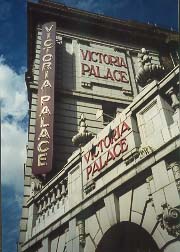
| |
| HOW DO I FIND THE VICTORIA PALACE THEATRE?--Aren't three signs enough for you? Photo: ©Glenn Loney 2000/The Everett Collection. | |
[02] Lucie Arnaz Flies in "Witches of Eastwick"
[03] Ambassadors Theatre Group Mergers
[04] "La Cava"—the New Visigothic Musical
[05] Ken Campbell's Anal Anecdotes at the Cottesloe
[06] Simon Callow Reveals Charles Dickens
[07] "Antipodes"—World Upside Down at Sam Wanamaker's Globe
[08] "Busy Day"—Fanny Burney's First Play
[09] Irish Film Extras Animate "Stones in His Pockets"
[10] New Ambassador's "In Flame"
[11] Flowers for Princess Diana
[12] Inside the Millennium Dome
[13] Inside the New Tate Modern Powerhouse
You can use your browser's "find" function to skip to articles on any of these topics instead of scrolling down. Click the "FIND" button or drop down the "EDIT" menu and choose "FIND."
How to contact Glenn Loney: Please email invitations and personal correspondences to Mr. Loney via Editor, New York Theatre Wire. Do not send faxes regarding such matters to The Everett Collection, which is only responsible for making Loney's INFOTOGRAPHY photo-images available for commercial and editorial uses.
How to purchase rights to photos by Glenn Loney: For editorial and commercial uses of the Glenn Loney INFOTOGRAPHY/ArtsArchive of international photo-images, contact THE EVERETT COLLECTION, 104 West 27th Street, NYC 10010. Phone: 212-255-8610/FAX: 212-255-8612.
New London Season Begins To Heat Up—
Bank Holiday weekend at the end of August is not the best time to sample theatre in London. Either in the West End—saving up its new shows for openings later in September—or in the institutional theatres, preparing for the new season as well.Also, as some musicals seem doomed to run forever, there is not much turn-over in that department. Andrew Lloyd Webber's "Cats," "Starlight Express," and "Phantom of the Opera" are soon to be joined by his latest musical effort, "The Beautiful Game."
Lord Webber also owns two of the most impressive musical theatres in the West End. One is the Palace, which features "Les Misérables," though it's not one of his shows.
The other is the historic Theatre Royal Drury Lane, home of historic long-running musicals. The long-run record here was broken by "Miss Saigon" way back in 1995, when it reached 2,182 performances.
It closed last October, with a record-breaking 4,263 performances. It has been replaced by the world premiere of a new American musical, yet to be seen on Broadway.
Lloyd Webber and his Really Useful Company—a Swiss Army Knife is its logo—now control the theatres of the Stoll-Moss Empire, which include such famed West End venues as the Garrick, the Cambridge, the Palladium, the Apollo, the Duchess, the Queens, the Gielgud, the Lyric, and Her Majesty's, longtime home of "Phantom."
Lord Webber restored the Palace handsomely and made it a place to have luncheon and natter about theatre, even if one was not going to a musical there. The Drury Lane, leased to fabled producer Cameron Mackintosh, has also been restored to mint-condition elegance.
I had forgotten how really awesome the Theatre Royal is. Marveling at the grand foyers and great rotunda of the Drury Lane, the imposing statues of great actors, and the dazzling crystal chandeliers, I realized why this all seemed new to me.
Because most of the theatre's long-runs were American shows I'd already seen on Broadway, I had not been inside for years.
After seeing the new Cameron Mackintosh-produced musical—also not one of Lord Webber's—I probably won't get to see the historic theatre-interior again for several years. This is a high-powered show, with very expensive "production-values."
Even on a Bank Holiday Monday evening, when many are out of town, the house was packed. And the audience raved, responding to the energy on stage.
Lucie Arnaz Flies Over the Audience
In Drury Lane's "The Witches of Eastwick"
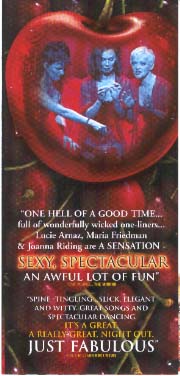
| |
| JOHN UPDIKE'S TALE BECOMES A "NOVEL" MUSICAL--Now at the Theatre Royal Drury Lane, "The Witches of Eastwick," with a flying Lucie Arnaz. | |
My guess is that producer Cameron Mackintosh thought it might be a safer bet to mount what looks like a wonderfully colorful—but slightly retro—vintage American musical away from the Great White Way and its carping critics.
After all, who in Manhattan remembers the creators of "Zombie Prom"? The American team of book-lyricist John Dempsey and composer Dana P. Rowe are not exactly up there in the Broadway Pantheon along with Rodgers & Hammerstein or Kander & Ebb.
Casting about for a subject for a new musical two years ago—as the program notes reveal—the duo was at a loss. Until producer Mackintosh gave them a list of Warner Bros. Films.
Way down at the end, in the W's, they found the film-version of John Updike's uproarious and sexually outrageous novel: "The Witches of Eastwick."
This "property" they have adapted for the musical stage, in effect recalling the vintage musicals of the 1950s and 1960s. The great old musicals for which many feel such great nostalgia. Even those who weren't yet born then.
From the audience reactions—and the critical responses—the duo and Mackintosh may well have found a winner in this story of three lonely ladies. In small-town Eastwick, in very small Rhode Island, they pine for fulfillment, not least sexually.
One of them, Sukie [Maria Freidman], is having a difficult affair with the drunken editor [Stephen Tate] of the local newspaper. His militant wife, Felicia, is the scourge of the town, ensuring propriety and protection of egrets.
The most stunning of the trio of lovelorn friends is Alexandra Spofford, a radiant Lucie Arnaz, too long away from Broadway. Her teenage son is in love with Felicia's browbeaten daughter, who must go cross country to
UC/Berkeley. Brown University, on top of that high hill in Providence, would seem an obvious choice. But her controlling mother wants her far away from her local boyfriend.
The trio is completed by Jane Smart [Joanna Riding], a prim school-teacher with a penchant for the cello. It soon appears she needs something else between her legs, such is the none-too-subtle suggestiveness of this tale.
When the Devil comes to town and buys that mysterious old mansion, the women's lives begin an abrupt change. In the person of Darryl Van Horne—the horn suggesting not only his head adornments but other equipment as well—Ian McShane transforms the amateur witches into glamorous charmers.v Speaking of charm, McShane manages the difficult feat of being simultaneously smarmy and charmless. The secret of his stardom eludes me.
Having successfully—and easily—seduced all three women, Van Horne lies on his luxurious red bed, surrounded by the lusty ladies. "I feel like such a whore," he remarks, to huge guffaws from the audience.
This is certainly not the morality or agonized sexual longing of vintage American musicals. But otherwise it looks very much like a stunning revival of one of the best.
This is largely thanks to the brisk comedic direction of Eric Schaeffer and the high-powered choreography of Bob Avian and Stephen Mear.
Designer Bob Crowley's striking costumes are not only colorful and parodic-vintage, but their silhouettes and details instantly provide the visual stereotype for the characters, even of the townsfolk in the chorus.
His rapidly moving set-pieces are also stunning. Out of the rolling green hills of Rhode Island rise tiny models of New England houses.
Von Horne's palatial all-red entrance foyer—with a red staircase to make Norma Desmond green with envy—looks like a Liberace wet-dream. Good taste is hardly the point.
When the Devil is about to marry Felicia's daughter—the three witches having successfully wished Felicia dead, after she vomited frogs and similar oddments—Crowley's oddly-angled First Methodist Church erupts in showers of sparks and collapses.
Having seen what havoc witchcraft can cause, the trio has wished him back in Hell, as he has made Eastwick something of a Hell for them as well.
This dynamic show is worth seeing for Crowley's sets and costumes alone.
But such songs—and their musical-stagings—as "Dirty Laundry," "I Love a Little Town," and "I Wish I May" are also sure to please a wide, undiscriminating public.
"Who's the Man?" is, however, a bit short in the good-taste department—though long on verbal and gestural indications of penis-size. Van Horn, apparently, has the Long Horn, the lack of which makes wives witches in Eastwick and elsewhere.
Stripped of John Updike's unique style and satiric sensibility, the story is fundamentally unpleasant. But, packaged so dynamically and colorfully, that will hardly be noticed by TV-deadened audiences.
When Cameron Mackintosh brings "The Witches of Eastwick" to Broadway, let's hope he brings Lucie Arnaz back with it!
Meanwhile, as the new musical's creators couldn't find anything else on the Warner film-list worth adapting, maybe they should go down the list of American novelists who have won the Pulitzer Prize. Or even take a look novelist Nobel Prize Laureates?
Actually, the du o already has a new musical project with Disney. But how about a show based, say, on a novel by Nobel Prize-winner William Faulkner?
Imagine "Light in August" as a Disney musical?
That Other West End Theatre Combine:
The Ambassadors Theatre Group/ATG
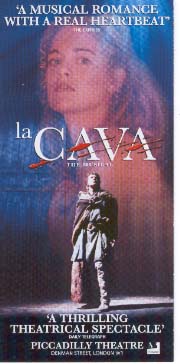
| |
| MUSICAL VISIGOTHS & MOORS SING IN SPAIN--"La Cava," the musical with Florinda, an Anti-Heroine. | |
Its current big musical hit is "La Cava," at the enormous Piccadilly Theatre. And it will shortly salute the new season with a D'Oyly Carte revival of "The Mikado," in Gilbert & Sullivan's historic venue, the Savoy Theatre.
The success last season of the G&S film, "Topsy-Turvey," should make audiences eager to see what a D'Oyly Carte production looks like today. Its new " Mikado" certainly shouldn't resemble the vintage staging in the film, mounted by W. S. Gilbert himself.
Early October, ATG will unveil "The Guardsman"—based on Ferenc Molnar's comedy—at its Albery Theatre. This promising musical was workshopped last spring in New York at the Vineyard Theatre. From Zeckendorf Towers, on East 15th Street to the West End, no less!
At the ATG's Whitehall Theatre, the show is "Cooking with Elvis." At the Phoenix, Willie Russell's "Blood Brothers" may just run forever. It's already had two good runs on Broadway. If you missed it, it's alive and well in the West End.
"Divas at the Donmar" is currently showcasing Betty Buckley. This is ATG's Donmar Warehouse venue, where some notable new shows have originated.
ATG also owns the Comedy Theatre—with Simon Callow as Charles Dickens; the Duke of York's—with the Irish comedy, "Stones in His Pockets"; Wyndham's Theatre—with the very long-running "ART," and, of course, the New Ambassadors, from which it takes its corporate name—with "In Flame."
"La Cava"—The Musical About the Woman
Who Made Moorish Conquest of Spain Possible
"La Cava" may not be a very compelling—or ticket-selling—title for a powerful new musical, but its producers seem to be stuck with it. In fact, scanning the listings of new shows in the West End, I thought it might be one of those marginal ads for Italian restaurants in the theatre-district.
It conjured up images of spaghetti bolognese and cheap red wine, in a cave-like cellar, illuminated by sputtering candles.
Actually, Cava does have something to do with a hole, but in this folk-usage, it means a whore. The anti-heroine of this music-drama—rather like Shakespeare's Cressida—cannot keep her love-hate priorities clear.
When the musical comes to Broadway—as it most certainly should—I hope they will give it a much more potent and interesting name.
"The Death of the Last Visigoth King of Spain" won't make the marquee. But that is a decisive part of the show's tumultuous climax.
"The Treacherous Archbishop of Toledo Betrays King and Country To the Moors" is much too long for Broadway signage. But that is a crucial turn of the intricate plot.
But that title might offend Mayor Rudy Giuliani—in the name of all Catholic Voters of New York.
"From Ceuta to Toledo/From Garrison to Royal Court" indicates the journey the unfortunate heroine Florinda makes from Spanish North Africa to the mainland capital. But that's not an audience-magnet either.
We've come a long, long way in what is now permissible in print and in public. But "The Whore" is an over-the-top title.
How about just plain "Florinda"? It is an unusual name. And she is a most unusual young woman.
The story is a kind of anti-Camelot, for the already married King of the Visigoths falls deeply and illicitly in love with the daughter of his best friend, commander of the North African garrison, where Florinda was born.
But, as with King Arthur's Round Table and fabled Camelot, the Spanish King is slain and his empire is dissolved, overrun by fierce Moorish warriors.
Whose descendants will occupy Spain for some 500 years—and threaten Christian Europe. But that aftermath is not in the musical. This show already has incident enough.
The new musical has a fascinating, complex book by Dana Broccoli, daughter of the late "Cubby" Broccoli, producer of the James Bond movies. It is based on her novel about Florinda, as an example of a woman who changed history.
But this dynamic musical is not just another costumed history-lesson, set to music. It is, instead, a very powerful story about love frustrated, denied, and disastrously fulfilled.
Sent from Ceuta to Toledo by her soldier-father—who fears Moorish uprisings—Florinda is abruptly and unwillingly separated from her secret lover, a young Moorish prince.
When he comes secretly to Toledo to take her back to Africa with him, he's caught and killed by the King. Florinda vows revenge, although the King has already shown marks of affection.
She sends a message to her father that the king has dishonored her. This is enough—such was the Spanish Code of Honor for centuries—for her father to join the Moors in invading Spain.
By the time Florinda realizes she's carrying the king's child, she has forgotten revenge and fallen deeply in love with the also besotted king.
But it's too late to stop the bloody war she has set in motion.
This plot is the stuff of opera, and Verdi would have made a major work out of it.
Fortunately, that won't be necessary now, for composers Laurence O'Keefe and Stephen Keeling have created a very powerful score to magnify the emotions raging in this confrontation of women and men, Christians and Moors, soldiers and priests, subjects and monarch, and betrayers and betrayed.
John Claflin and O'Keefe have devised often affecting lyrics which also heighten the drama and the passions. Some are choruses for rousing production numbers.
Others are laments for what might have been, or ecstatic expressions of emotion, untroubled by forethought.
As in the best of operas and musicals, the songs belong in their scenes. They do advance the plot—frequently replacing dialogue. They do reveal character—sometimes with a vengeance. And they certainly help create mood and atmosphere.
Among outstanding songs are "Life Is Worth Living," "First Kiss," "Stay with Me," and "No Other Way." These titles, however, do sound bland and clichéd. As with the musical's title, they give no clue to their dramatic powers in the show.
This is a show with a number of important roles for talented singers, not just two or three stars. Outstanding in the London cast are Julie-Alanah Brighten as Florinda, Oliver Tobias as King Roderic, David Bardsley as Florinda's father, Marilyn Cutts as the long-suffering Queen, Daniel Redmond as Florinda's Moorish lover, Louisa McCarthy as Florinda's friend at court, and Patrick Romer as the evil, Jew-hating Archbishop.
The musical has no less than 26 scenes. It at first seems an endlessly unfolding pageant of colorful costumes and settings.
But set-designer Frances O'Connor has cleverly contrived a multitude of effects with fairly basic elements.
The center of the stage is a revolve, decorated with Visigothic patterns. It permits constantly flowing changes of locale and scene.
The major unit-set element is a great arcaded wooden wall, spanning the stage. It is a series of doors on two levels, backed by a balcony, so it can be reversed and played on both sides.
It moves down and up stage in grooves, with doors open to slide over set-props for new scenes. It can divide in the center and pivot towards the upstage, or it can form side-walls for a wooden chamber or exterior—with a similar fixed wall upstage.
Colorful filmy drapes descend and rise, open and close, revolve with the movement of the turntable, and even get caught up to form ship's sails and army tents.
These scarf-like hangings are either boldly colored in bright hues, bordered with Visigoth designs, or they appear as richly decorated tapestries in fainter hues and details.
Dance sequences also make vivid use of color in costuming and props. A visit to a Toledo market by Florinda evokes a wild dance with bright cloths being energetically flared in the air.
Mitch Sebastian has created the often breath-taking choreographies. Some of them are violent battle-dances. And some are simply charming or even witty.
Steven Dexter, as director, has helped weld all these elements together to create a very powerful show indeed.
If Broadway is really eager for strong book-musicals, with great songs, tremendous production values, strong roles for talented actor/singers, "La Cava" should make its debut as soon as possible in New York.
At the Royal National's Cottesloe Theatre:
Comedian Ken Campbell Gives a "Bum" Rap!
Alan Ayckbourn's two interlocking plays, "House" & "Garden"—played simultaneously by the same cast on the Lyttelton and the Olivier stages of the Royal National Theatre were unfortunately not on view my pre-season week in London. I didn't think I could survive a third "Hamlet" in one month—even with Simon Russell Beale as the Dane—so I opted for "Ken Campbell's History of Comedy" in the intimate Cottesloe.
Campbell is a stand-up comedian/philosopher, with a bent toward the Absurd. There will surely be more of these evenings, for this production is only Part One of his Saga of Comedy.
It is titularly dedicated to Ventriloquism. But that's only a peg on which to hang a many-colored fools-cap full of observations about speech as communication and ritual: its origins, its impulses, its production, its variations.
In fact, although Campbell does demonstrate the ventriloquist's means of production of difficult speech sounds without moving the lips—and has the audience try them out—he has a lot of loosely allied anecdotes to share.
He's at times in danger of giving the audience a "Bum" Rap, so fascinated is he with the history and talents of Gastromancers—who work wonders, but not with their mouths.
Gastromancy sounds like Necromancy—the Black Arts—but it deals with the spirits of the dead in different way. Gastromancers—beginning in Ancient Egypt and extending over the ages—have been able to detect malign spirits of the dead with their sensitive anuses.
Campbell notes how useful this must have been to ancient Egyptians "moving house." Before you moved into your changed lodgings on the banks of the Nile, you had the Gastromancer in to suck up the possibly evil spirits through his anus into his belly. There you could listen to them—before your spirit maven farted them out. And good riddance!
A lean, lanky figure, Campbell demonstrates several times how this process must take place. His body is supple and his face mobile.
His bald pate is framed by a fringe of gray hair, complemented by bushy gray eyebrows. Initially, his head is covered by a jaunty black hat, complementing his loose-fitting black jacket and looser blue T-shirt. He is the picture of the Casual Man.
Behind Campbell is a huge wooden hand carved as a chair, a shelf with ventriloquist's dummies and other items, a stand with figures, and a bed with pictures of large dogs—as nurses for children. Although he doesn't mention Nana in James Barrie's "Peter Pan," who was nurse for the Darling children.
Overhead is a long, colorful banner which illustrates the History of Comedy, Ventriloquist Division. This he uses to highlight his anecdotes.
On it are images of sled-dogs, as well as the Egyptian god who was the first ventriloquist. Campbell even enters with three sleek black dogs.
He has one of them pull a wheeled cart around the stage. He's thinking about Jack London's "Call of the Wild," and the regression of a domesticated dog to wolf-like state in the Alaskan wilderness. What would that primal wolf-speech have sounded like?
At the close, Campbell brings back one of the dogs and drives him wild with howling.
Campbell is a member in good standing with the North American Ventriloquists Association and has a card to prove it. He also brought back from their 1999 meeting in Kentucky a puppet-head that looks just like him—carved by a master who died shortly after it was finished.
Kentucky, Campbell points out, is central to ventriloquists because it's the state which has Vent Heaven, a repository of beloved puppets of ventriloquists who willed them to the museum's founder. Who lived to be 90—and kept on collecting.
He notes that ventriloquists hate it when their "Knee-pals" are called "dummies." Often, they seem smarter than their flesh & blood friends.
On the banner, Campbell points out several images of the famed Edgar Bergen. His major puppet, Charlie McCarthy, has passed over into American folklore.
Charlie sometimes uttered—on national radio and TV—incisive and satiric comments which no one else, certainly not Edgar Bergen, would have dared to make.
When the aged Bergen finally decided to give his wooden friends a rest, he made a farewell appearance in Las Vegas. After the last show, he returned to his hotel-room, where he died.
Campbell notes that the newspapers said he died alone in bed. But Bergen was not alone. He was with his beloved Charlie, Effie, and Mortimer Snerd.
The puppets or knee-pals are also known as Shaman-Sticks. They are used by those tribal priests who can raise the dead, see into the future, and be possessed by the gods.
That there is also powerful phallic symbolism in these magic wands with the talking-heads is obvious. They empower their owner/manipulator.
He gets a laugh talking about a shy man—with a working-class accent—in a bar who could converse only through his "Shy-Man Stick."
Like the all-licensed medieval jester, the puppets or sticks can say what no one else dare utter. Campbell says that at ventriloquists' conventions, when they are chatting, it's most often the puppets who talk to each other, not their owners.
Pointing to a picture of Paul Winchell & Jerry Mahoney on his banner, Campbell notes that they were one of the biggest TV attractions in the 1950s in the United States. But when an aged Winchell tried to recover the tapes of his broadcasts—to which he had copyright—the producing company erased them.
Among Campbell's anally-fixated tales is his report of a visit to a former East German Stasi Archive. On shelves he saw jars of what he thought were dead herrings.
No, he was told. They were wads of lint.
People being interrogated by the Stasi were made to sit on lint. Apparently, the ordeal caused them to emit such pungent odors that Stasi dogs had only to sniff the lint from the jar to be able to track that individual.
Campbell is also fascinated by the production of sounds of intelligible and not-so- intelligible speech. He speculates on the first kind of speech Man must have used.
Could it have been a kind of Glossolalia? That is the production of a random jumble of sounds which might be words in other languages. Campbell offers some wild demonstrations.
He points out one of the masters of this divinely inspired talent, Montanus of Phrygia. He was the center of a great movement, inspired by the Feast of the Pentecost, when the Holy Spirit sent tongues of fire so that new Christians of many languages could understand each other.
At least in the Early Church, Glossolalia—or Speaking in Tongues—was believed to offer important revelations. And be a mark of special piety and favor.
Unfortunately—even today in Pentecostal Churches—almost no one could or can understand what was or is ecstatically uttered. It has to be interpreted.
Discovering the writings of Gertrude Stein, Campbell had the astounding insight that Stein's peculiar patterns of language are, in fact, "Glossolalia interpreted," as he phrases it. So he has a Gertrude Stein puppet with whom he can have conversations.
Campbell is also fascinated by the idea of The Missing Vowel. He hold high a copy of a French novel, written entirely with words which have no letter "e" in them.
There's also an English translation, but because English is so different from French, the translator had no easy time finding equivalents.
He even offers to share a few lines of Edgar Allan Poe's "The Raven," written with no "e's." The translator calls his version "Blackbird."
This missing "e" is not to be confused with the schwa sound [from the German Schwach, or weak], which is often spelled with an "e," but is, in fact, an unaccented "uh" sound.
Campbell's brisk, amusing presentation left no room for "uhs' or "duhs."
No Longer Emlyn Williams as "Boz"—
Now Simon Callow's Charles Dickens
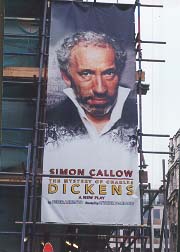
| |
| A BANNER-DAY FOR DICKENS--Simon Callow on scaffolding of Comedy Theatre. Photo: ©Glenn Loney 2000/The Everett Collection. | |
Actually, Williams had his readings "cut out" for him, for Dickens had very carefully cut actual printed texts of his novels and stories down to an evening's performance length. The originals of some of these lectern-texts are now in the Berg Manuscript Collection of the New York Public Library on 42nd Street.
Simon Callow, however, is emulating neither Emlyn Williams nor Charles Dickens. Even makeup and hairpieces could not make him resemble the author of "David Copperfield."
The physical difference between the two noted performers is visually emphasized at the Comedy Theatre.
Entering the intimate auditorium, the audience sees a full-stage scrim, painted with an image of the seated Charles Dickens. Behind him, his bookshelves have come alive with teeming characters and scenes from his most celebrated novels.
This fanciful vision melts away, as lights behind the scrim rise to illuminate a seated Simon Callow. Although he is dressed in Victorian garb, with his oval face and white frizzy hair, he looks nothing at all like the author of "A Tale of Two Cities."
Nor is he imitating Dickens' platform readings, as Emlyn Williams did. Only snatches of scenes, or snippets of characters, are evoked by Callow.
He does them very well, however. Especially riveting is his suggestion of Bill Sykes and Nancy, as Bill prepares to murder her.
Dickens himself did not spare his audiences this horrendous scene. Even though, as Callow tells us, it was a wrenching experience for him to recreate this savage killing again and again.
Directed by Patrick Garland, Simon Callow is actually acting Peter Ackroyd's monologue, "The Mystery of Charles Dickens." This he does very well indeed.
In outlining the notable public career and the often hellish private life of the author of "Oliver Twist," Ackroyd is in danger of a sequence of "And then he wrote's." But he deftly avoids this by relating the progression in Dickens' literary development to events in his own life.
Ackroyd is an expert on literary and historical mysteries. His novels about the young poet Thomas Chatterton, the architect Nicholas Hawksmoor, and the mysterious astrologer Dr. John Dee are all intriguing studies.
But there seem no new mysteries in this Ackroyd text. Unless it is the still-unanswered question of why Dickens drove himself literally to death with the killing schedule of concert-readings which helped end his life.
And there is no mystery about Dickens' failure to finish "The Mystery of Edwin Drood." He died before he could conclude it.
How should he have ended it? When "Drood" bowed on Broadway as a musical, the audience got to vote for alternative endings. The real mystery was why anyone would want to make this unfinished work into a musical.
Dickens' various biographers have already examined in amply foot-noted detail all of the incidents and character-quirks noted in Akroyd's monodrama. Such as the decision to build a brick-wall in their bedroom, to separate his increasingly detested wife from the author of "Our Mutual Friend."
Callow is certainly not a callow man or actor. In fact, he has written a book about acting which, if not an actor's bible, has the flavor of Holy Writ.
As the impassioned narrator of the life and works of the author of "Great Expectations," Callow does not disappoint audience expectations. He performs with tremendous dynamism, but suggests even more repressed emotional power.
This two-part show obviously "has legs." It was commissioned—surely with touring in view—by the Ambassador Theatre Group and ACT.
It should tour widely. And, as did Dickens himself, with his own readings, it should come to America. To the Americas—all of them!
Dickens is, after all, by now universal. And it needn't be a bare-bones tour, with only a table, chair, and lectern.
Designer Christopher Wood has devised—in addition to the fanciful Dickens scrim—a simple stage-space, framed in front by an immense Victorian gilt picture-frame. Upstage, another gilt-frame, only slightly smaller, encloses a cloud-scape.
To throw this symmetry off—as Dickens' often chaotic life did his work-habits—only a corner-section of another gilt frame stands at an angle stage-right, disappearing into the wings.
Found in the Drama Attic—Revived at the Globe:
Brome's "Antipodes, or The World Upside Down"
Richard Brome was at one time Ben Jonson's man-servant. He may have learned a lot about playwriting from his master, as well as how to lay out his clothes. But he lacked Jonson's biting irony. His 1638 "The Antipodes, or, The World Upside Down" has been briskly revived at Sam Wanamaker's reconstructed Globe Theatre on Bankside Thames. This was one of Sam's dearest dreams: not only to see Shakespeare's plays performed in his historic playhouse, but also other dramas by the Bard's contemporaries.
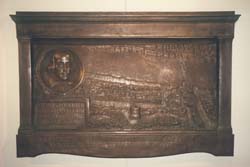
| |
| WILL SHAKESPEARE IN BRONZE--Plaque in Sam Wanamaker's Globe Theatre Exhibition. Photo: ©Glenn Loney 2000/The Everett Collection. | |
Brome's misfortune was to have won attention only shortly before Cromwell and his Puritans closed down all the London theatres in 1642.
With the favorable response of some critics and many spectators, "The Antipodes" seems a likely choice for further revivals in regional, college, and community theatres. Brome's "A Joviall Crew" and "The Sparagus Garden" may also provoke renewed interest in their production.
"Antipodes" has been deftly directed by New York's Gerald Freedman—the man who first staged "Hair" at Joe Papp's Public Theatre, before Tom O'Horgan mounted it on Broadway. He also staged Shakespeare's works at the Public and in Central Park for Papp.
Freedman's problem at the new Globe is not essentially with the comedy itself. Even though it is hardly Jonsonian in its wit.
Nor does Freedman have problems with the stage-space, the two front pillars, nor the two side-doors and center upstage "discovery" area.
The difficulty lies with the unevenness of the cast. Some of whom seem recruited from community or college theatre.
Fortunately, Geoffrey Beevers, as the ingenious Dr. Hughball—in a severely elegant Elizabethan costume provided by Jenny Tiramani—is excellent. Tim Preece is good as Blaze, as is Joanna McCallum, as his wife, Barbara.
The Argument of the play is that Dr. Hughball shall attempt to cure the travel-mad fantasies of a distracted young husband, Peregrine Joyless. And, at the same time, bring the alienated husband and wife together.
But Peregrine's father, Lord Joyless—who has brought him to London for this cure—also needs to be healed of his insane jealousy of his lovely young [second] wife Diana [Penny Layden].
All these cures are accomplished with the device of a play-within-the-play, devised by the very theatrical Lord Letoy and his raffish company of players. They also enlist the others in their improvisation.
They drug Peregrine, to make him believe he has slept for days, before reaching the "Antipodes," where everything is topsy-turvy. Being upside-down, on the other side of the earth, everything is exactly the opposite of London customs: aged schoolboys, women who duel, and honest lawyers, etc.
All these paradoxes offer abundant opportunity for hilarious visual and vocal antics. For theatre-fans—and academics and students, as well—the insights into the details of physical production of the plays of this period can also prove fascinating.
Believing he is battling monsters, Peregrine has stumbled into the ensemble's property-room. A frantic actor rushes on stage to tell Lord Letoy of the havoc Peregrine has wrought among the props, outlining a long list of regalia and fantastic items, including the "wooden pies."
This well-intentioned Globe production should spark others—possibly more effective—on differently conformed and equipped stages.
Informed Elizabethans and Jacobeans, after all, went to the theatre to "hear a play," not specifically to see it.
Sam Wanamaker's decision that the Globe stagings should only be lit by light of day—or the occasional candle, lantern, or torch—proves a dismal disaster when it rains. As it did the afternoon I saw this show.
For evening performances, a modern compromise has been made, with a basic flood of neutral white light to illuminate the players and stage.
On a stormy day, Shakespeare and Company would not have played. But our Groundlings got soaked. And everything on stage—including the colorful decorations on the stage itself—looked almost uniformly gray.
Perhaps that's what made some of the performances look gray as well?
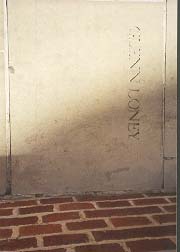
|
| STEP ON IT!--The Glenn Loney Stone inside Door Three of Sam Wanamaker's Bankside Globe Theatre. Photo: ©Glenn Loney 2000/The Everett Collection. |
To help with construction costs, supporters of the new Globe project were invited to contribute, with their names to be put on stones in the courtyard. At intermissions, you walk on the famous: Lord Olivier, Vivian Leigh…
A lot of people get to walk all over GLENN LONEY. My stone is right inside Door 3.
In the adjoining Shakespeare Globe Exhibition, there's also a copper Supporting Wall, with autographs of later donors. My autograph is also inscribed, but there is room for many more names. Yours can be there as well!
Contact the Globe Appeals Office: 011-44-207-902-1457. Or try the website: www.shakespeares-globe.org
Fanny's First Play Has Premiere 200 Years Later:
Burney's "A Busy Day" Makes Its West End Debut

|
| RIDICULOUS REGENCY ARISTOCRATS--Fanny Burney's "Busy Day" mocks them in words as well as cartoons. |
Burney, the witty and intelligent daughter of an indulgent doctor-father in London Society, made a name writing incisive, ironic, and amusing novels about that privileged world.
Her sensational "Evelina" and later novels spawned scores of less rewarding stories by well-bred young ladies—who previously had no approved outlet for literary talent. Or lack of it…
Burney was also an important influence on Jane Austen, who refined her techniques.
The playwright and Drury Lane Theatre manager, Richard Brinsley Sheridan, was so impressed with her ability to assess character and bring it alive on the page that he suggested she write a comedy for him.
Unfortunately, she was in the wrong place at the wrong time—France in the Napoleonic era—and it never got produced. The play was finally discovered among family papers in America.
It was only published in the 1980s, but never had a really professional production until it was recently mounted by the Bristol Old Vic. It was so well received that it transferred to London. To one of Andrew Lloyd Webber's many theatres: the Lyric.
This is a charming, intimate theatre, suggestive of the 18th century playhouses in which "A Busy Day" might successfully have been performed.
Although the play has a certain charm, it is not a lost "School for Scandal." It certainly is, however, a Sentimental Comedy, the genre which dominated the 18th century London stage.
In order to expose self-important, cruel, and snobbish London aristocrats to ridicule, Burney opposes them to a noisy, bumptious, vulgar, tasteless City of London newly-rich merchant family. Social Commentary and ridicule at both ends of the scale!
In Burney's time, everyone with bon ton had moved away from the City and its "Cits," westward to Piccadilly and Bond Street.
People "in trade" stayed behind. But Mr. Watts [a bluff, good-natured Richard Kane] has sold his business handsomely and—prodded by his stupid wife [Carol Macready] and beau-hungry daughter [Carolyn Backhouse]—has donned a powdered wig and also moved to the West End.
In their earlier years of poverty, the Watts "fostered" their older daughter, Eliza [the gracious Megan Hall], out to a gentleman in India. It was then the custom to foster or apprentice children families could not afford to raise.
He has recently died, leaving Eliza an heiress. So she returns to London for a reunion with the family she scarcely remembers. Nor they her.
In India, she has fallen in love with a handsome, but penniless, gentleman, Mr. Cleveland [a stalwart Simon Robson]. He returns on the same ship.
The entire play occurs on one day in 1800. Not only is Eliza appalled by the vulgarity of her own family, but so are Mr. Cleveland's titled relatives.
The gouty Sir Marmaduke Tylney [John McCallum] is only concerned with the mortgage on one of his estates. His second wife, Lady Wilhelmina [magisterially played by Stephanie Beacham], has her nose so high in the air that it seems to suck all the oxygen out of rooms the instant she enters.
Mr. Cleveland stands to inherit both title and lands if he marries a silly, willful heiress [Sara Crowe] who is more than eager to consummate the relationship.
He fears his family will never accept Eliza because of her ghastly parents.
Fanny Burney apparently had already made up her mind on that old question: Which is more important, Nature or Nurture? It isn't Eliza's DNA that makes her such a sensitive, refined lady. It is the way she was raised in India.
The major plot complication is one of Mistaken Identity. Arriving in London, her coach crashes outside a gentleman's club. There, two young sparks are taken with her charms.
One of them is Mr. Cleveland's even more penniless younger brother, Frank [flamboyantly played by Ian Kelly]. When he discovers Eliza is an heiress, he resolves to marry her.
Misunderstandings about which Mr. Cleveland is in hot pursuit keep the plot moving along until the formulaic resolution. Each Cleveland gets the lady he deserves.
The Bristol Old Vic production, designed by Ruari Murchison, created a variety of attractive scenes with flair and fairly minimal means. Jonathan Church staged artfully, highlighting confrontations and social gaffes.
The program for "A Busy Day" is a collector's item in itself, with a wealth of information and images about the London of Fanny Burney's time.
It is a shame that the production was taken off at the end of August, but the hordes of tourists outside on Shaftesbury Avenue seemed headed for the nearest McDonalds. Not for productions of 18th century Sentimental Comedy.
From Playwright-Infested Ireland:
Marie Jones' "Stones in His Pockets"
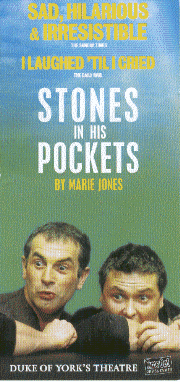
|
| THERE'LL ALWAYS BE AN IRELAND--Making a Hollywood Historical Epic, with two Irish Extras playing all the roles in "Stones in His Pockets." |
As I was buying my tickets, I feared I'd already seen it at either the Dublin Festival or the Edinburgh Festival. But I couldn't be certain.
There are so many new Irish plays these days, William Butler Yeats and Augusta, Lady Gregory—founders of the Irish National Theatre—should be either delighted—or appalled.
The box-office cashier did say it was shown last year on the Edinburgh Fringe. But was it at the Traverse—where I see most everything on offer? He didn't know.
Entering the auditorium, I immediately recognized the long row of shoes, stretching upstage from one side to the other. And the cloud-scape above them.
Downstage, there was a prop-box on wheels. In its transparent front, it seemed to be filled with some kind of white material.
But in London, as in Edinburgh, the two men who play all the roles kept taking out and putting in changes of costume and props. They lifted a lid which is hinged on the front, so the audience cannot see what is hidden behind the white stuff.
I obviously see too many shows. At that moment, all I could remember from the Edinburgh production was wondering how that prop-box was really constructed—to seem almost empty, yet contain so many costume-changes?
I had of course read that the show was about the experiences of two otherwise unemployed Irishmen, working as extras on a pretentious Hollywood Historical Irish Epic.
What I had forgotten—or what did not really show to good effect in Edinburgh in the very small performance-space—was the fact that the two also play all the imperious Hollywood types—men and women—as well as a number of distinctive Irish locals.
As staged by Ian McElhinney—for the proscenium-arch stage of the Duke of York's Theatre—the virtuoso talents of Conleth Hill [Charlie Conlon] and Seán Campion [Jake Quinn] proved outstanding in the new frame.
Each can change in an instant from, say, a vitriolic Irishman to a fluttering woman continuity-director. These lightning transformations need no costume-props—though they sometimes get them—for the character-studies and voices are so precise and clear. Including the emotions which go with them—which the duo can drop in an instant.
The ever optimistic Charlie never tires of trying to flog a few pages of a potential screen-play to anyone who will read it. Jake, the pessimist, humors him for a while but finally tells him how terrible it is.
The title, "Stones in His Pockets," refers to a local lad, a dreamer and outsider. In terminal despair over his life in the village, he fills his pockets with stones and walks out into the ocean.
This is not played, only described. As a close friend of Charlie, the young man's suicide requires his presence at the wake and the funeral.
Indeed, all the locals feel they should go, out of respect for the family. But the director is frantic, as the film is already over-budget.
But the extras also need the very good money they are earning and could be laid off. One canny old codger—who continually reminds all that he was an extra in John Ford's "The Quiet Man"—points out that their faces are already on film.
He thinks they cannot be replaced.
So this unusual drama has a Major Dramatic Question: Will this pretentious film actually get finished, given all the Hollywood and Irish human and social problems?
It isn't just an ingenious play-device to provide two excellent actors with a tour de force. But it does do that very well.
So well that it should be seen soon on Broadway. It is far more interesting than the wildly over-praised "The Weir." And certainly more virtuosic than "The Beauty Queen of Leenane."
But "Uplifting" is not exactly the word I would use to describe the powerful effect—both hilarious and sobering—of "Stones in His Pockets."
At the New Ambassador,
Charlotte Jones' "In Flame"
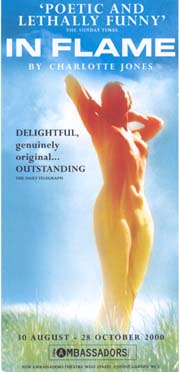
|
| NAKED PASSIONS--Charlotte Jones "In Flame" moves back and forth between 1908 and now. |
A hit at the Bush Theatre before its West End Transfer, it won author Charlotte Jones the Critics Circle Award for Most Promising Playwright.
But how curious that two of the new season's most interesting new dramas were written by women with the surname of Jones! Other women dramatists are going to have a difficult time "Keeping Up With the Joneses."
"In Flame" floats back and forth from Yorkshire in 1908, to Millennial London 2000. The same performers play their antecedents—or people close to them. At first, this is a bit confusing, but it soon works well in both time-frames.
With the spirits of those long gone, still hovering about those living in the new century. Trying to resolve mistakes or miscarriages of the past: seeking closure.
In 1908, in Yorkshire, a stern, man-hating, puritanical matriarch [Marcia Warren] must marry off her ugly-duckling daughter, the shyly lovely Livvy [Emma Dewhurst]. She pairs the self-effacing girl to a local fool [Ivan Kaye], an Albert Herring type.
But the poor girl dies in child-birth.
It is her mad younger sister, Clara [Rosie Cavaliero]—who hears and sees ghosts through the walls of their home—who in effect has a child for her. A friendly con-man/drifter [Jason Hughes] gives her momentary pleasure in exchange for a secret she has told him.
Nearly a century later, the child—now a dying old woman [Warren] in a home—treats her own dutiful daughter [Kerry Fox] with disdain, rather like her own grandmother back in 1908. She imagines she was a big-time show-dancer, taps and all.
She's cared for by a male nurse with a sadistic side—who has fallen in love with her daughter. The daughter, however, dishonestly convinces her flat-mate—played rambunctiously by Cavaliero, who was the mad girl—that he's attracted to her instead. He's impersonated by Kaye, who played the foolish husband of 1908.
The up-to-date careerist daughter is sleeping with a married man—who is played by Jason Hughes, the 1908 con-man photographer. He is not going to get a divorce for her sake.
If all this seems incredibly complicated, it actually works very well, without unduly confusing viewers. It is also very well observed, in terms of human needs, desires, and dreams—all of them frustrated by will or circumstance.
It certainly has its comic moments, but its powers are more subtle, sad, and even poetic. "In Flame" is exactly the kind of British drama the Manhattan Theatre Club produces so successfully.
Charlotte Jones' agent should send a copy of the play to Lynne Meadow at once!
Flowers for Diana!
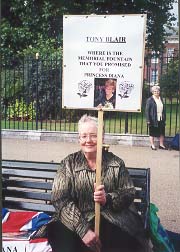
|
| DIANA, WE STILL LOVE YOU!--Demonstrater outside Kensington Palace—former home of Princess of Wales—where hundreds of bouquets were displayed on her death-day. |
There were many hand-made posters, largely-writ letters, photos of Princess Di, and even some stuffed animals. Having photographed the scene last August, I noted fewer bouquets and less bizarre presentations.
TV cameras were at the ready for any snippets of news, memories, or moral outrage. One adamant woman had a hand-card asking Prime Minister Tony Blair about the fountain he allegedly promised to construct to Diana's memory.
In effect, another form of Theatre-in-the-Park!
Will this annual ritual outpouring of grief continue long? Or will it die away? No Miraculous Cures have yet been reported, but one woman assured me that Diana still had the power to heal, "as she had in life."
Inside the Millennium Dome!

|
| INSIDE THE MILLENNIUM DOME--Blue sails at the summit, aerial decor for huge free show spectacle á la Las Vegas. Photo: ©Glenn Loney 2000/The Everett Collection. |
So this augured well for the success of the venture, also highly endorsed by many Big Names.
It would give new life and purpose to a barren patch of land on the Thames, adjacent to the Docklands developments, notably the monumental Post-Modernist Canary Wharf.
The necessary new Underground connections—which cost billions to build—now link the land with Greenwich across the Thames, with Canary Wharf, and with Stratford [not the one Upon Avon!] and other communities to the east.
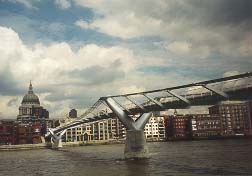
|
| BRIDGING THE MILLENNIA--Sir Norman Foster's brand-new Post-post-Modernist Millennium Footbridge—across the Thames River from St. Paul's Cathedral to the New Tate Modern—has been closed because of tremors caused by pedestrians. bPhoto: ©Glenn Loney 2000/The Everett Collection. |
Years ago, avant-garde theatre-director Joan Littlewood proposed that a People's Palace be constructed—possibly in the abandoned mammoth shell of the Battersea Power Station. She was recalling the great days of Regency Pleasure Gardens, such as Vauxhall and Ranalegh.
But her vision was of entertainments, eats, and enjoyment for ordinary working-class people. Not the aristocratic elite and prosperous bourgeoise who once thronged Vauxhall.
That vision was never fulfilled. Today, Battersea is a ruined shell, made even more precarious by the filming of some battle-scenes for Ian McKellen's "Richard III" there.
The Millennium Dome, however, is a very up-to-date version of Littlewood's Pleasure Palace. It is essentially a vast circular fabric tent, held aloft by cables moored to great slanted girders in a ring—which poke at angles through the roof.
It is an enormous space inside. Planners have not had an easy time filling it, either with special displays or with people.
The media, supportive before the opening, were dismissive and damaging as soon as the Dome was open for business. Press people were backed up in the North Greenwich Station, as Security made sure the Royals and Politicos were ushered in first at the Official Opening. The media have been getting even ever since…
I made a quick visit—just to photograph the outside of the Dome and its surface amenities—soon after it opened. School-kids, on holiday, were jamming the place.
When I returned this past Bank Holiday, I arrived at the opening hour of 9:30, to find almost no one gawking at the various walk-through exhibits.
At the press-center, I got a couple of coupons for shows and for getting to the heads of the lines for exhibits. No need.
I walked right through a number of them. Not that they were not worth my time. Not at all.
But most are keyed—as at Hannover's EXPO 2000—to Politically Correct Attitudes and Environmental Concerns. And, as at EXPO, they are all ingeniously designed to make their various subjects and themes both attractive and simplistic.
Almost all the exhibits are really innovative and striking in design. They are also devised—as at Disneyland—to move as many people as swiftly onward as possible.
The effect is rather like a Chinese dinner, disguised as Futurist Techno Info. Two hours later, you're almost hungry for information again!
The various pavilions—excluding the McDonald's and other eateries—are dedicated to Topics or Themes which are similar to the concerns of those at EXPO 2000: Work, Learning, Money, Rest, Mind, Faith, Talk, Journey, Body, Play, Shared Ground, Living Island, Home Planet, and Timekeepers of the Millennium.
One wall in the Faith Pavilion was devoted, as the large letters indicated, to JESUS IN ENGLAND.
At EXPO 2000, the Vatican has its very own pavilion, while a much larger building is devoted to Christian [Protestant & Catholic] faiths. At the Dome, all the major religions have their various walls.
One solution to filling the immense space inside the Dome has been to surround its central area with banks of seats. A stage in the center is capable of varied elevations for the Millennium Show.
With its aerialists, bungee-cord acrobats, dancers, lavish costumes, props, and floats, it is the North Greenwich equivalent of a major Las Vegas show.
If the Dome was almost empty in the morning, by noon showtime, all the seats were packed, with many sitting on the floor between the tiered seating and the performance arena.
After the show, long lines formed at all the major pavilions, so the Dome seems to be doing all right, despite gloomy reports in the media.
Outside the Dome, you were sure to win a stuffed animal—"No One Loses!"—at one of several lucky-throw galleries, festooned with colorful animals and octopuses.
A very large adjacent theatre offered nine showings daily of segments from the popular and hilariously off-color British TV series, "Blackadder."
The simplest—but most impressive—of the external attractions, however, is a long marble strip. This marks the Greenwich Zero Meridian as it passes through the site.!
If you cannot make the trip to Hannover for EXPO 2000—which closes in October—give yourself a treat and visit the Millennium Dome. It is EXPO in miniature—and it should be open at least to the end of this millennial year.
Inside the New Tate Gallery of Modern Art!
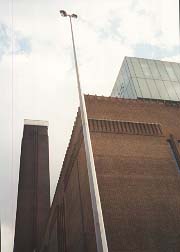
|
| CUBIST VIEW OF NEW TATE MODERN--Long abandoned Battersea Powerhouse transformed for avant-garde artworks. Photo: ©Glenn Loney 2000/The Everett Collection. |
Grand historic interiors—such as London's immense Art Deco Bankside Power Station—might be best preserved with the artifacts for which they were constructed left intact and in place.
The giant turbines which once churned out electricity for London's lights and industries have been alas removed. This is most unfortunate, for they were surely a splendid monument to the arts of design & technology in the 20th century.
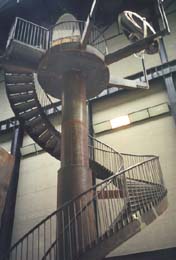
|
| SPIRAL STAIRCASE AS SCULPTURE--There's more to Louise Bourgeois' immense welded construction than immediately meets the eye in the great Turbine Hall of the new Tate Modern. Photo: ©Glenn Loney 2000/The Everett Collection. |
These immense constructions are the first annual Unilever Commission to fill this space. If Damien Hirst is commissioned in a year or two, will he be able to fill the great void with sliced sections of cows-in-formaldehyde?
The more wall and floor-space well-intentioned architects have provided for Museums of Modern Art, the larger are the subsequent series of paintings, sculptures, and "installations."
Art-lovers don't get more art on view, but bigger artworks. It's a self-fulfilling prophecy.
And, in much avant-garde art that is called modern, post-modern, or post-post-modern, bigger is not necessarily better. Unfortunately…
But the new Tate Modern is at least free—unlike MoMA in New York. Also free are the Tate Britain and the Tate Liverpool.
The Tate Britain now showcases [some of] the best of British art from 1500 to the present. But, as with the Tate Modern and MoMA, the emphasis in exhibition is now on subjects and themes, rather than on schools or movements.
Some of these thematic rooms at the Tate Modern are: Manifestos, Structures for Survival, The Figure as History, Modern Art in Conflict, Confession & Confrontation, Writing History, The Perceiving Body, Naked & Nude, The Myth of the Primitive, Transfiguration, Automation, Acting Out, Landscape Exposed, Rethinking Landscape, Inner Worlds, Matter & Space, Marks & Locations, Ways of Seeing, The Desire for Order, Modern Life, A New Objectivity, Intimate Lives, The Intelligent Object, and Subversive Objects.
New Yorkers have recently been exposed to this new way of presenting artworks at MoMA. It enrages some conservative critics, but it has a real appeal to viewers who are interested in the different ways artists treat similar subjects and objects.
It seems The Wave of the Future in art exhibitions.
[Loney]
Copyright © Glenn Loney 2000. No re-publication or broadcast use without proper credit of authorship. Suggested credit line: "Glenn Loney, New York Theatre Wire." Reproduction rights please contact: jslaff@nytheatre-wire.com.
| home |
reviews |
cue-to-cue |
welcome |
| museums |
recordings |
coupons |
publications |
classified |